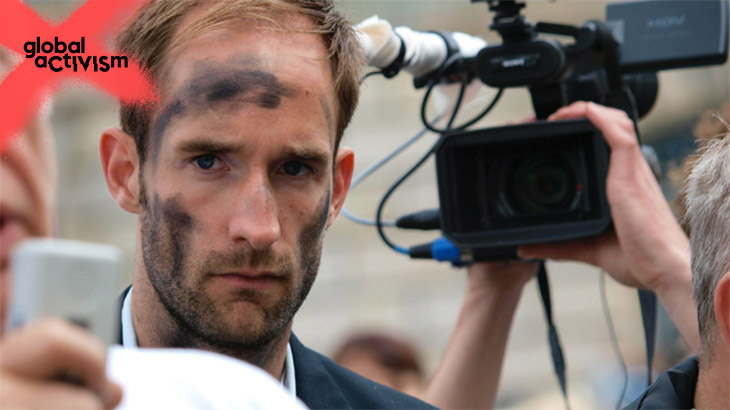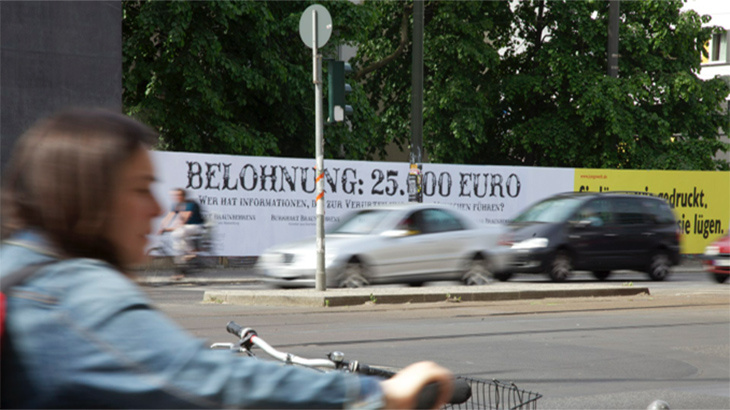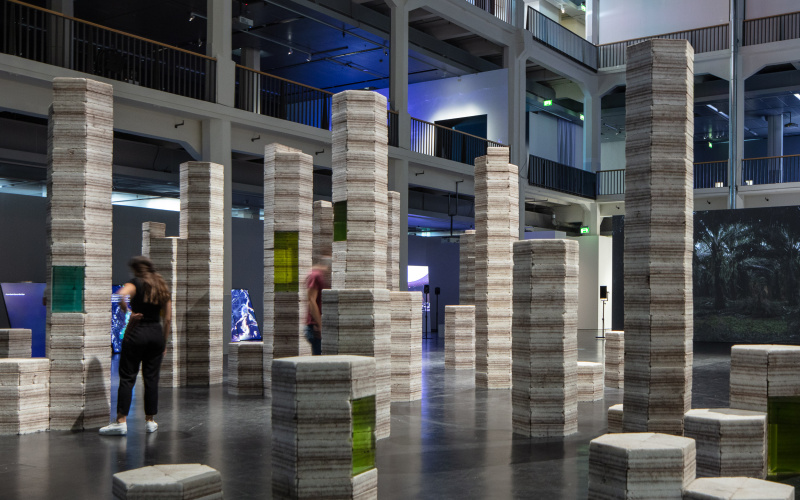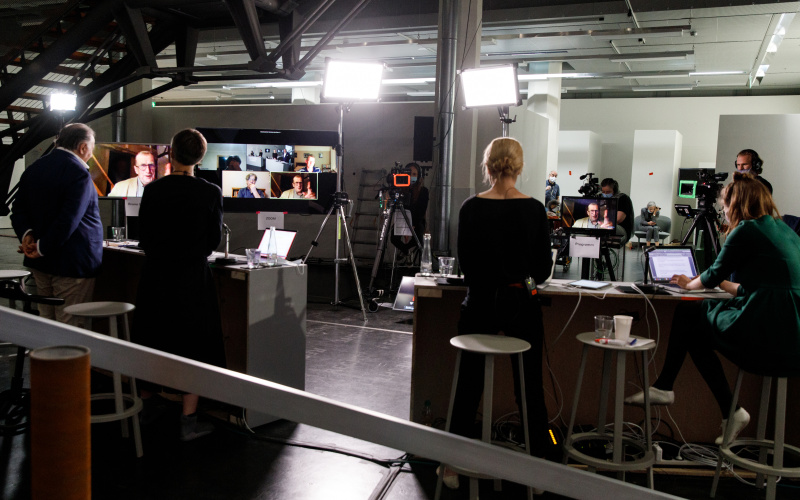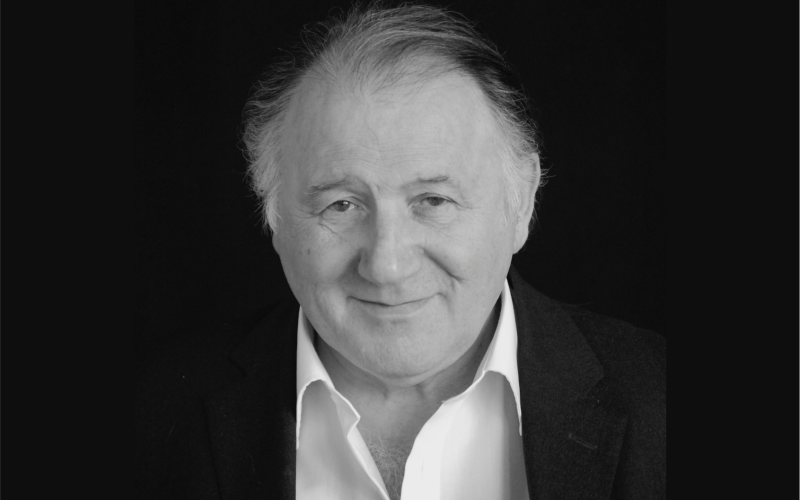Illegal Actions II
On the Correct Medication of Political Action Art
In the museum that is part of Berlin’s Memorial to the German Resistance, there is a black file, which was put together by historians, that is labelled “Illegale Maßnahmen I” [Illegal Actions I]. The oversize file contains the more harmless activities against the Nazi regime on paper: construction plans for duplicating machines and printing presses. Inevitably, the visitor wonders: Where is File No. 2 with directions on how to forge passports, fake official stamps, and build bombs? However, the file labelled “Illegale Maßnahmen II” [Illegal Actions II] has gone missing. Not even the friendly lady attendant knows what has become of it. The presence of the first part and the absence of the sequel is symptomatic of the frame of mind prevailing in the Federal Republic of Germany.
One can literally see the last CDU minister of defence strolling through the memorial, his gaze alighting by chance on the file “Illegal Actions II,” and getting it confiscated immediately. Or a state secretary rushes on ahead, checks the compilation, gets frightened by the radicalism of the content, and instructs the curator while shaking his head: “This is not acceptable!” At any rate the overview exhibition attests to this all-pervasive fear of treading on someone’s toes in the present-day. There are no detailed accounts of what any of the protagonists of German resistance actually accomplished in it – against their careers, against their friends, against their feelings.
When one day, historians analyze the despondency of our time, they should start by looking at these exhibition texts. Anyone searching for examples of what courage looks like, can only discover that using a lot of imagination (this does not apply to the part of the exhibition entitled Was konnten sie tun? [What Could They Do?]). Any internet search with the words “assassination attempts on Hitler” is more revealing. Obscured by bureaucratese it says there: “He was of the opinion that ethical and moral grounds warranted the killing of Hitler.” One would like to hear someone – for example, the secretary general of Amnesty International, a man who in a risk-free environment and looking forward to retiring on a fat pension manages the budget of the world’s largest human rights organization – just say something similar once about the Syrian or Russian dictatorships. What would he have to fear? A drop in donations? Didn’t he once want to fight for human rights? By all available means?
For years now, the Center for Political Beauty has stood for performance art that historians will one day overwrite with “Illegal Actions II.” We live in a country that has morphed into a huge bathtub. The population is already wallowing comfortably inside it, waiting for warm water and relaxation. The tub, though, only fills up with purely fanciful fears. In below-zero temperatures, the Germans then lie around feeling sorry for themselves while attempting not to get the cramps. Free but frozen. Free of oppression, but without courage. Art must burst into the bathroom with the imaginary fears, and provoke, accuse, and hurt. We can fight the battle for the last remaining utopia – the enforcement of human rights – in a more aggressive way, a lot more aggressive.
During a media-hacking action in 2009, the Center for Political Beauty spread the announcement that the Federal Foundation Flight, Expulsion, Reconciliation was planning to give three refugees seats on the foundation’s board. In 2011, we exposed the criminal position of Deutsche Bank in connection with food speculation. In 2012, we put a price of 25,000 Euros on the heads of the owners of the German munitions company Krauss-Maffei Wegmann, to put them behind bars for their weapons deals (Leopard II. tanks for Saudi Arabia). The action generated a lot of attention, and innumerable articles were published. This huge media resonance led to one of the arms dealers talking on ZDF television – contrary to usual practice in his line of business – which led to his expulsion from the board of directors and associates of the company. Rupert Neudeck, forward thinker of radical humanism, said at the time: “This attempt is genius. If I can be part of it, I will.”
Last year we began to collect donations to hermetically seal off the weapons factory Heckler & Koch in Oberndorf with a large steel and concrete sarcophagus like the wrecked nuclear power plant in Chernobyl. Every month more people die from their weapons than the total of people who lost their lives in Chernobyl.
Our children, too, will ask one day what the hell we were actually doing at this time. I also constantly ask myself why, in the 1990s, my parents just watched while three genocides (Bosnia, Rwanda, Chechnya) took place, and how is that reconciled with their understanding of history. The Germans constantly ask: Would I have also murdered Jews in 1941? They should ask themselves: Would I have handed out leaflets? Does aggressive humanism actually still exist? The first flyer of the White Rose says: “Do not forget that each nation deserves the government it puts up with!” These days, the file “Illegal Actions I” is the medication for this “toleration” – anyone who wants to go a step further than just tolerating needs to pick up the file “Illegal Actions II.” www.politicalbeauty.de
Further information on: www.global-activism.de
About the author
The opponent of the establishment Philipp Ruch is director, founder, and chief negotiator of the Center for Political Beauty, a think tank to explore moral beauty, political poetry, and human holistic ethics, dubbed by the media as “the most interesting project of German artists since Group 47.” Ruch studied political philosophy with Volker Gerhardt, worked in the research area of the history of emotions (Max-Planck-Institute), and was research fellow at the Collegium for the Advanced Study of Picture Act and Embodiment (Horst Bredekamp). The subject of his PhD thesis was Ehre und Rache. Eine Gefühlsgeschichte des antiken Rechts [Honor and revenge: The history of emotions in law in the ancient world]; the supervisors were Herfried Münkler and Hartmut Böhme. The national weekly newspaper DIE ZEIT included Ruch in its list of one hundred students “from whom we shall be hearing again in the future.” He has developed the concepts of numerous exhibitions, including for the 7th Berlin Biennale, the Neue Gesellschaft für Bildende Kunst (NGBK), the ZKM | Karlsruhe, and the 6th Berlin Kunstsalon. During the temporary use 2004–2005 of the Palast der Republik [Palace of the Republic] in Berlin, the seat of the parliament of the German Democratic Republic, while the building was awaiting demolition, Ruch curated the art film festival Nacht der 7 Traurigkeiten [Night of the seven sadnesses]. In 2009, the Bosnian foreign minister thanked Ruch for his work in keeping memories of the war alive. In 2012, Ruch was awarded the German Web Video Prize, and in 2013, he was member of the honorary jury of the 33rd World Universities Debating Championship (WUDC).
____________________________________
Notes
Translated from the German by Isaac Custance
Category
News Category
- tracks & records
